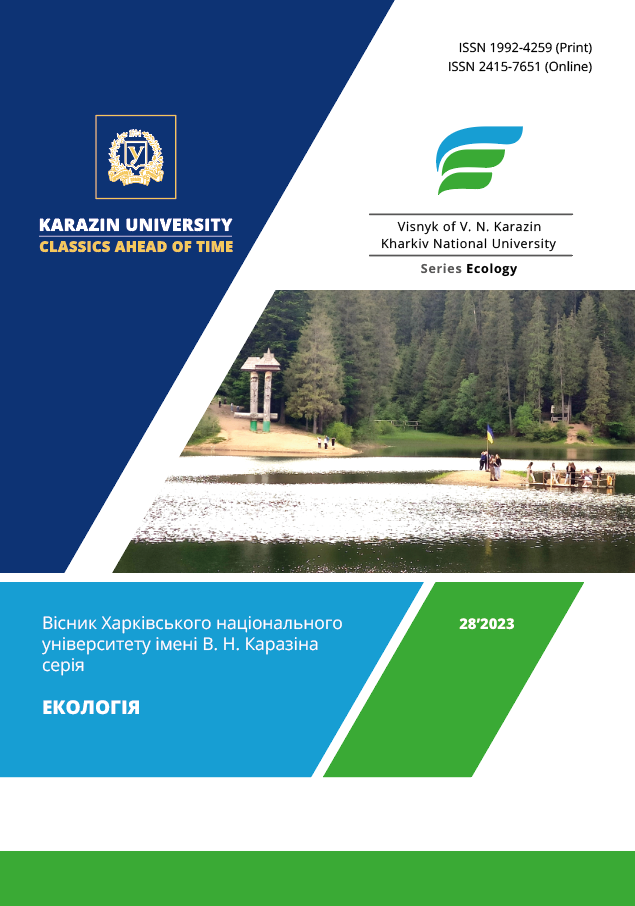Токсикологічна оцінка якості очищення бурових стічних вод
Анотація
Мета. Визначення оптимальної комбінації та витрат коагулянтів і флокулянтів при очищенні бурових стічних вод з подальшим визначення гострої летальної токсичності отриманої освітленої рідкої фази.
Методи. Первинне освітлення рідкої фази відходів буріння проводилося методом хімічної коагуляції з використанням у якості коагулянту органічних коагулянтів «Magnafloc» та «ECOFLOC». У разі недостатності ступеню очистки бурових стічних вод методом коагуляції застосовувався додатковий спосіб очищення флокулянтами Zetag 8180 та камеддю целюлозною. Після процесу очищення виконували токсикологічний аналіз бурових стічних вод за методикою біотестування для визначення гострої летальної токсичності води на ракоподібних Ceriodaphnia affinis Lilljeborg.
Результати. Проведено низку дослідів щодо визначення оптимальної витрати коагулянтів та флокулянта для очищення бурових стічних вод. Визначено, що найбільш ефективне очищення відбувається при первинному освітлення рідкої фази відходів буріння методом хімічної коагуляції з використанням органічного коагулянту «Magnafloc» та додатково флокулянтом Zetag 8180 у концентраціях 1,2 г/дм3 та 1 кг/м3, відповідно. При використанні цих хімічних реагентів у вищеозначених концентраціях, в очищених бурових стічних водах визначено 2 рівень гострої летальної токсичності (вода слаботоксична). Встановлено, що найбільш ефективне очищення відбувається при первинному освітлення рідкої фази відходів буріння методом хімічної коагуляції з використанням коагулянту «ECOFLOC» та флокулянтом - камеддю целюлозною у концентраціях 1,2 г/дм3 та 1,3 кг/м3, відповідно. При використанні цих хімічних реагентів у вищеозначених концентраціях, у очищених бурових стічних водах визначено 2 рівень гострої летальної токсичності (вода слаботоксична).
Висновки. Загалом слід зазначити, що такі стічні води потребують більш ретельної доочистки, в разі можливого скиду до водних об’єктів, і їх використання можливе лише у повторних технологічних процесах буріння. Результати біотестування необхідно використовувати для скринінгу високотоксичних екологічно небезпечних хімічних речовин та контролю токсичності різних категорій стічних вод на всіх стадіях їх утворення та на скидах у водні об’єкти як інтегральний показник при контролі їх якості.
Завантаження
Посилання
Leonard, S. A. & Stegemann, J. A. (2010). Stabilization/solidification of petroleum drill cuttings. Jour-nal of Hazardous Materials, 174, 1–3, 463-472, https://doi.org/10.1016/j.jhazmat.2009.09.075.
Pantelitsa, L., Voukkali, I., Zorpas, A., Pedreño, Jose N., Chatziparaskeva, G., Inglezakis, J., Vardopou-los, I. & Doula M. (2012). Measuring the level of environmental performance in insular areas, through key performed indicators, in the framework of waste strategy development. Science of The Total Envi-ronment, 753, 141974, https://doi.org/10.1016/j.scitotenv.2020.141974.
Sadiq, R. & Husain, T. (2005). A fuzzy-based methodology for an aggregative environmental risk as-sessment: a case study of drilling waste. Environmental Modelling & Software, 20 (1), 33-46, https://doi.org/10.1016/j.envsoft.2003.12.007.
Njuguna, J., Siddique, S., Kwroffie, L. Bakah, S., Addae-Afoakwa, K., Ekeh-Adegbotolu, U. & Oluyemi, G. (2022). The fate of waste drilling fluids from oil & gas industry activities in the exploration and pro-duction operations. Waste Management, 139, 362-380, https://doi.org/10.1016/j.wasman.2021.12.025.
Kraynyukov, O. M. & Kryvytska, I. A. (2023). Technology of local cleaning of the liquid fraction of drilling mud from specific pollutants. International Scientific Journal "Internauka", 3. 90-92. https://doi.org/10.25313/2520-2057-2023-3-8617
Kraynyukov, O.M., Kryvytska, I.A. & Kraynyukov, O.O. (2020). Evaluation of the effectiveness of the use of modern drilling mud detoxification technologies. International scientific journal "Internauka", 16, 9-11.
Khanpour, R., Sheikhi-Kouhsar, M.R., Esmaeilzadeh, F., & Mowla, D. (2014). Removal of contaminants from polluted drilling mud using supercritical carbon dioxide extraction. The Journal of Supercritical Fluids, 88, 1-7, https://doi.org/10.1016/j.supflu.2014.01.004.
Elnenay, M., Nassef, E., Farouk, G. & Abdel Magid, M. (2017). Treatment of drilling fluids wastewater by electrocoagulation. Egyptian Journal of Petroleum, 26(1), 203-208. https://doi.org/10.1016/j.ejpe.2016.03.005.
Pereira, Laine B., Sad, Cristina M.S., Rayane, Mayara da Silva, Corona, R.B. & Lacerda V. (2019). Oil recovery from water-based drilling fluid waste. Fuel, 237, 335-343. https://doi.org/10.1016/j.fuel.2018.10.007.
Guo, B., Zhang, S., Xu, X., Gao, B., Li, Q. & Yue, Q. (2023). An enhanced coagulation using ferric chlo-ride and poly-ferric chloride coagulant assisted by polyamidine: Performance and mechanisms. Chi-nese Chemical Letters, 108379, https://doi.org/10.1016/j.cclet.2023.108379
DSTU 4173-2003. (2004). Water quality. Determination of acute lethal toxicity to Daphnia magna Straus and Ceriodaphnia affinis Lilljeborg (Cladocera, Crustacea) (ISO 6341:1996, MOD). Kyiv: Derzhspozhivstandard of Ukraine, (In Ukrainian)
Kraynyukova, A. M., Kraynyukov, O. M., & Kryvytska, I. A. (2021). The use of biotesting techniques to assess the ecological status of surface waters. Bulletin of V. N. Karazin Kharkiv National University, series "Ecology", 24, 103-116. https://doi.org/10.26565/1992-4259-2021-24-09 (In Ukrainian)
Ablieieva, I.Y. (2020). Assessment of environmental safety of solid phase of drilling sludge after centrifusion separation. Scientific and technical journal «Technogenic and Ecological Safety», 8, 3–11. DOI: 10.5281/zenodo.4300735.
Adamenko, Y.O., Kundelska, T.V., & Nikolyk, M.M. (2005). Assessment of the impact of the development of oil and gas condensate deposits on the environment. Еxploration and development of oil and gas deposits. 3(16), 53-58. (In Ukrainian)
Авторське право (c) 2023 Крайнюков О. М., Кривицька І. А., Житнецький І. В.

Цю роботу ліцензовано за Міжнародня ліцензія Creative Commons Attribution 4.0.
Автори, які публікуються у цьому журналі, погоджуються з наступними умовами:
- Автори залишають за собою право на авторство своєї роботи та передають журналу право першої публікації цієї роботи на умовах ліцензії Creative Commons Attribution License 4.0 International (CC BY 4.0), котра дозволяє іншим особам вільно розповсюджувати опубліковану роботу з обов'язковим посиланням на авторів оригінальної роботи та першу публікацію роботи у цьому журналі.
- Автори мають право укладати самостійні додаткові угоди щодо неексклюзивного розповсюдження роботи у тому вигляді, в якому вона була опублікована цим журналом (наприклад, розміщувати роботу в електронному сховищі установи або публікувати у складі монографії), за умови збереження посилання на першу публікацію роботи у цьому журналі.
- Політика журналу дозволяє і заохочує розміщення авторами в мережі Інтернет (наприклад, у сховищах установ або на особистих веб-сайтах) рукопису роботи, як до подання цього рукопису до редакції, так і під час його редакційного опрацювання, оскільки це сприяє виникненню продуктивної наукової дискусії та позитивно позначається на оперативності та динаміці цитування опублікованої роботи (див. The Effect of Open Access).





